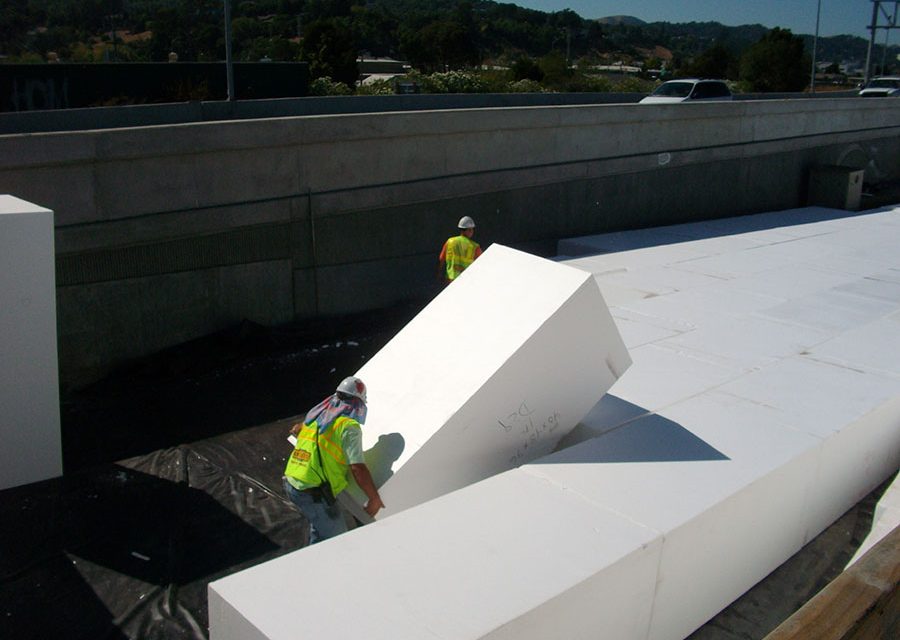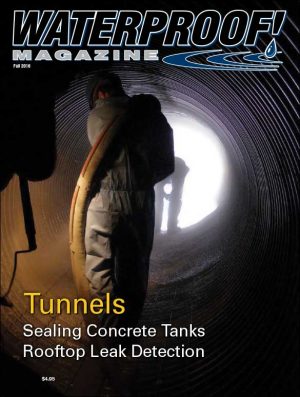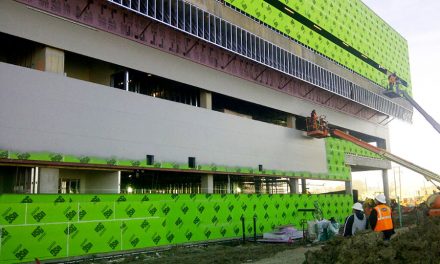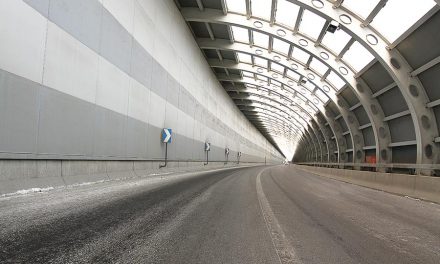EPS foam is becoming familiar to an increasing number of waterproofers, such as this crew working on a highway project near San Rafael, California.
Many waterproofing contractors are familiar with rigid EPS foam. It is frequently used as an insulated protection board on residential basements, and in ballasted roof assemblies. But EPS foam can be encountered in a number of other waterproofing applications as well.
Increasingly, foam is being used as a lightweight alternative to gravel and other fill, in order to solve engineering challenges. When used in this function, the material is termed “geofoam.” Waterproofers frequently encounter geofoam in projects built on soft soil or steep slopes. But it is also used for lateral load reduction on retaining structures, as structural void fill, and for buried utility protection.
Typically, the driving factor for using geofoam in place of regular fill is its ultra light weight. At one or two pounds per cubic foot, it’s 99% lighter than natural products. That makes it perfect for roofs and decks and soils with poor load-bearing capacities. As a side benefit, even the most enormous blocks of foam can be placed by hand, reducing the need for heavy equipment, and simplifying construction on tight jobsites and steep slopes.

Despite its light weight, geofoam is remarkably strong. It can be produced with strengths up to 2,678 pounds per square foot, and as long as the combined dead/live load does not exceed one percent strain, EPS geofoam will never creep or experience plastic yield. These strength standards are specified in ASTM D-6817, Standard Specification for Rigid Cellular Polystyrene Geofoam.
EPS is popular for roofing and foundation applications because it will absorb very little water, which is an advantage in geofoam applications as well. It will continue to insulate and protect even when completely submerged.
Because of these advantages, even though the cost of EPS geofoam is typically higher than traditional materials on a cost per cubic foot basis, these costs are usually offset by savings elsewhere in the project.
Light Weight
In Chicago, planners were designing a 20-acre park on the Lake Michigan shoreline. The twist was that much of Maggie Daley Park would be built atop a 4,000-car parking garage.
Chicago Park District CEO Michael Kelly said at the time, “We’re going to transform what was a flat, sort of uninviting area into a gem for Chicago.”
Landscape architects wanted to construct hills and landscape contours throughout the space. Soil would be the typical choice, but it was too heavy for the garage to support. Instead, the park designers specified EPS geofoam as a durable, ultra-lightweight fill alternative.
Approximately 100 times lighter than soil, it enabled designers to create a visually interesting landscape and still keep the garage in place. “It allows you the freedom to be creative,” said Peter Schaudt, FASLA, partner with Hoerr Schaudt Landscape Architects, in an article in the Chicago Sun-Times.

More than 100,000 cubic yards of geofoam was placed under Chicago’s Maggie Daley Park to create a green roof with 30-foot hills
It was a massive undertaking, similar to other vegetated roof projects, but on a far more massive scale. First, the concrete roof of the garage was sealed with an asphalt-based product, and topped with a single-ply membrane. After leak testing, four inches of stone were placed on top to provide a drainage plain. Then the foam was placed. Contractors installed about 65,000 cubic yards of InsulFoam’s GF EPS geofoam, plus a similar quantity salvaged from the earlier Daley Bicentennial Plaza at the site.
In the sweltering months of June and July 2014, the site looked as if it were piled with acres and acres of snow. With the foam in place, yet another single-ply waterproofing membrane was installed over the rolling hills of foam. Finally, the growing media—regular topsoil—was placed. The following spring, landscaping and planting was finished. Completed in the summer of 2015, some visitors to the park are aware that the East Monroe Street Parking Garage lies beneath their feet, but only a few recognize the foam and waterproofing products that made such a space possible.
Geofoam in green roof applications is not unusual in Chicago. The technique was also used for the Daley Plaza renovation, where the trees are now growing, and to create a hilly and grassy landscape near Soldier Field and Museum.
Speed of Installation
Highway construction is another construction sector using large amounts of geofoam. Modifying freeway interchange
ramps often means carefully threading roads around existing support structures. The challenge becomes how to support such new roads without expensive and time-consuming modifications to existing structures, especially when they’re built on soft soils.
This was the challenge Maggiora & Ghilotti, Inc. of San Rafael, Calif., faced when widening State Route 37 about 40 miles inland from San Francisco. The highway serves as a vital connection between four counties in the North Bay Area. “The loose nature of the sediment and the dampness of the dirt really affect our ability to get heavy equipment in and out of the site,” says Vice President Scott Ghilotti.

On this highway project, the foam needed to be carefully wrapped and sealed in a petroleum-resistant membrane to protect it from the oil and gas in the roadway runoff.
To reduce loads, they used a geofoam from ACH Foam Technologies with a one percent compressive strength of 186 psi. Prior to placing the foam, the trench was lined with a specialized waterproofing membrane. It’s resistant to petroleum-based products in order to protect the foam from oil and gas contaminants in roadway run off.
The small crew was able to lay and configure an average of 1,500 yards of block a day. In total, they placed more than 15,000 cubic yards of geofoam. “We hadn’t ever used EPS geofoam before, but the guys at ACH Foam Technologies were really very helpful,” said Ghilotti.
As the sections of foam were put in place, the overlapping edges of the gas-resistant membrane were wrapped across the top and fused together to seal the blocks inside. With the structural fill in place, Ghilotti began the over-fill and grading process, moving dirt and gravel with machines weighing 35 tons or more. “Performing this work on top of wrapped foam blocks seemed like it would be a very delicate operation,” says Ghilotti. “It just didn’t seem possible that equipment that heavy could move around much on top of an embankment supported by foam blocks without damaging them.” The ACH team, however, assured him that between 12 and 18 inches of soil placed over the wrapped foam would be enough to support the weight of the heaviest equipment needed, and they were right.
Strength
Geofoam is also being used to create innovative rooftop pool structures. It was used, for instance, in remodeling a University of South Carolina student housing a few years ago. Genco Pools principal Dan Ball says, “Genco has been building pools for more than 27 years, but this project really pushed us to think differently.”
Plans called for building a large swimming pool between the top two floors of the existing parking deck. Because the pool was being built into an existing structure, it was a process of filling in rather than digging out, but finding a way to for the structure to support the weight of the pool and the fill proved challenging. The solution was geofoam. On a previous project, they’d used product from ACH Foam Technologies called Foam-Control, and believed it could solve this building challenge as well.

The area around this rooftop pool was built up with geofoam so the deck was at the same level as the pool edge.
“Despite being so lightweight compared to earth or concrete, the compressive strength of geofoam is really tremendous,” says Ball. “This allowed us to accommodate the full desired pool depths and even helped form the curved shape of the pool.”
The jobsite was located on Main Street in downtown Columbia, amid a bustling city center. “The city told us we could only have a piece of a lane on Main Street after 10 pm at night, so we worked with the manufacturer to have the product delivered through the night,” said Ball. “As the foam arrived, it was craned directly up to the roof deck of the parking structure and everything was out of the way so the street could be opened back up for normal morning traffic.”
It eliminated the need for concrete forms, too. In Ball’s estimation, even after more than 25 years in the pool construction industry, he’s pretty sure his team couldn’t have actually completed this particular project without geofoam.
“Between the reduced weight of this material, the high compressive strength, and the way the product is easily reshaped on site to accommodate equipment or other building materials that have to be placed within it, geofoam really saved the day.”
Spring 2016 Back Issue
$4.95
Rooftop Decking
Basement Remodels and Emergency Egress
Waterproofing and Geofoam
AVAILABLE AS DIGITAL DOWNLOAD ONLY
Description
Description
Rooftop Decking
These case studies outline the challenges and solutions to installing flat rooftop decking on both residential and commercial projects.
Basement Remodels and Emergency Egress
Basement contractors and waterproofers can increase profitability by adding egress installation to their services. Here’s how to make sure both the code and the owners’ budget are satisfied.
Waterproofing and Geofoam
Rigid EPS foam insulation is frequently found in roofing assemblies. But it can be encountered in a number of other waterproofing applications as well.
Additional Info
Additional information
| Magazine Format | Digital Download Magazine, Print Mailed Magazine |
|---|




















